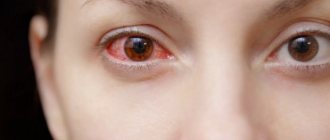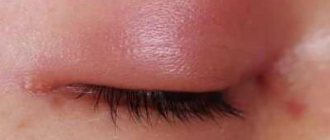November 04, 2016
Averyanova Sveta
Improper hygiene procedures, infections transmitted by airborne droplets or contact can be the reasons why a child’s eyes become sour in the first month of life.
To help the baby, every parent must understand the seriousness of the problem and not waste time. A timely visit to the doctor, finding out the reasons why the eyes turn sour in newborns, choosing treatment is the key to a speedy recovery.
Symptoms
Symptoms, in most cases, clearly manifest themselves in the morning.
The child begins to show the following signs of illness:
- In the morning, there is difficulty opening the eyes due to the fact that they are stuck together with dried mucous or purulent discharge;
- After opening the eyes, mucous contents accumulate in large quantities , especially at the corners of the eyes. When such a symptom occurs in infants, crying and irritability appear, the child begins to be capricious, and loses his appetite. Children of preschool or school age begin to complain of a burning sensation, stinging, and pain in the eye area. Sometimes children complain of a feeling of a foreign object or the presence of sand in the eye;
- Children actively try to remove a foreign object by rinsing their eyes under water or rubbing them with their hands;
- Mucous discharge from the eyes can be of different colors . This depends on the nature of the disease and the presence of purulent or bloody contents;
- Even after washing the eyes, the feeling of discomfort and pain does not go away. After an hour, new accumulations of mucus or pus may be visible.
Why do my eyelids turn sour?
The mucus can be either white or brown purulent. In order for the doctor to prescribe the correct treatment, it is necessary to determine the causes of the disease. Most often, the presence of mucus and discomfort provokes conjunctivitis. But it is accompanied by inflammation of the mucous membrane of the pupil. Dacryocystitis may occur in newborns. The symptoms of the diseases are quite similar, the causes of their occurrence are different and, accordingly, different courses of treatment are prescribed.
Dacryocystitis
It occurs due to obstruction of the baby's tear ducts. The discharge contains embryonic tissue that clogs the tubules. As a result, the liquid does not go into the nasal cavity, but is excreted through the eye. When it hardens, a crust forms, which causes souring in the baby. The danger is that the tear ceases to perform a bactericidal function, and microbes and pathogenic microorganisms get inside. Dacroicystitis is a rare occurrence, but requires timely and qualified treatment. The disease occurs only in newborns. If the eyes become very sour at the age of 2 or 3, this indicates the presence of another disease, most often conjunctivitis.
Conjunctivitis: which ones occur?
Kindergarten children have a higher risk of contracting a viral form of conjunctivitis.
Occurs at an early age. When bacteria and other pathogenic microorganisms enter the mucous membrane of the eyes, inflammation occurs. For doctors, this means “acute conjunctivitis.” Both eyes are affected, although there are cases of inflammation of one eye, but two need to be treated. It develops unevenly, one organ suffers more than the other. There are three types of conjunctivitis:
Other reasons
Swollen eyes, snot - all this also manifests itself in ARVI. Everything is natural, because with cold symptoms, the virus moves from one organ to another. The children themselves help the disease: they rub their nose, and then their eyes. A visit to the doctor is mandatory. Treatment of the root cause, the virus, will improve the condition of the eye system. At the same time, it is recommended to wash the eyes with saline solution, chamomile or Miramistin solution.
Causes
Acidity in a child's eyes can occur due to infection. Although the structure of the eye in young patients does not differ from that of adults, in childhood the protective functions of the body are not yet fully operational. Therefore, any even minor infection can trigger a pathological process.
Most often this is facilitated by:
- bacteria;
- viruses;
- allergens.
The penetration of allergens and pathogenic microbes into the baby's organs of vision causes conjunctivitis or dacryocystitis.
Dacryocystitis
This pathology occurs when harmful bacteria penetrate the lacrimal sac. As a result, the tear duct is blocked. Because of this, tears accumulate in the lacrimal sac, become inflamed and serve as a breeding ground for the development of pathogenic microflora.
Dacryocystitis occurs more often in newborns, and is accompanied by damage to one eye (two eyes are affected very rarely in 3% of cases).
The disease begins acutely and may be accompanied by:
- rising temperature;
- the appearance of chills;
- swelling may occur in the corner of the eye;
- swelling of the upper and lower eyelids develops;
- souring of the eyes occurs. Sour crusts may be white or yellow;
- If in the morning hours it is difficult for a child to open his eyes, they are stuck together with yellowish contents, this indicates that the inflammatory process is purulent in nature. This is a serious reason to visit the pediatrician.
If for some reason this pathology is not treated, the likelihood of developing:
- abscess;
- phlegmon.
These are dangerous diseases that can lead to vision loss.
Be sure to remember that:
- Dacryocystitis always begins acutely;
- This disease is not caused by allergens;
- In infectious inflammation, the lacrimal sac is primarily affected. Inflammation of the eyelids, a secondary symptom.
Bacterial conjunctivitis
In the etiology of this inflammatory process, streptococcal and staphylococcal infections are highly likely. The latent period (hidden) can last one week, after which the disease progresses into the acute phase, in which the inflammatory process can affect both eyes.
The child appears:
- Copious production of tears;
- Discharge of purulent contents . They may be dirty yellow or green. This leads to souring of the eyes and the appearance of crusts;
- Hyperemia of the eye sclera . This symptom is more pronounced with viral conjunctivitis. If it occurs due to bacterial pathology, this indicates a severe course of the disease;
- Sensation of a foreign object in the eye area, reminiscent of sand. This is the very first harbinger of conjunctivitis;
- Fear of bright light . This symptom increases pain in the eye area and provokes increased lacrimation, which leads to souring of the child’s eye;
- Signs of general intoxication make the child capricious, irritable, and cause symptoms of anorexia (loss of appetite);
- With the rapid progression of the disease , body temperature can rise to 39 degrees.
To make a correct diagnosis and provide qualified assistance, you need to contact an ophthalmologist or pediatrician.
Viral conjunctivitis
Infection with viral conjunctivitis most often occurs after a cold (flu, acute respiratory infection).
“Souring” of the eyes – what is it and how does it manifest itself?
Take a look at your baby in the morning and you'll probably notice that there is a small amount of dried discharge in the inner corners of his eyes. They are easily removed with water when washing. The daily appearance of such crusts is the norm. Crust composition:
- dried mucus secreted by glands located deep in the conjunctiva;
- dead epithelial cells;
- dust particles that get into your eyes during the day.
During wakefulness, all these substances are continuously removed by blinking; at night, the eyes are closed, and during the hours of sleep, eye secretions have time to accumulate and dry out. Under the influence of various factors (trauma, inflammation, dusty atmosphere), the amount of eye discharge increases and, when dried, forms a thick crust in the corner of the eye and along the edge of the eyelids. Sometimes there is so much discharge that the eyelids stick together and the baby is unable to open his eyes in the morning. In everyday life, this phenomenon is called “souring” and can occur for a variety of reasons.
A child’s eyes become sour and watery during ARVI or a cold
Against the background of influenza virus infection, souring of the eyes and purulent discharge occur against a background of elevated temperature. Viral infection most often develops in a weakened body.
Therefore, a small patient is first prescribed:
- Rectal suppositories (Anaferon, Interferon). They increase the body's protective functions, increasing its resistance to infection;
- To remove the remains of dried pus , it is necessary to rinse the eyes with a solution of chamomile or Furacilin;
- Before going to bed, you need to put Nitroxoline ointment behind the lower eyelid;
- To prevent further spread of the virus, it is necessary to rinse the nasal passages with saline solutions. You can also use Decasan eye drops.
About home treatment
Dr. Komarovsky has an extremely negative attitude towards self-diagnosis, treatment of inflammation, and the use of traditional methods. He does not recommend self-medication.
If the form is bacterial, you can wash it with an antiseptic chamomile solution or saline solution. For inflammation due to viruses, you can use any solution - chamomile, tea leaves, sodium chloride. Rinsing helps remove crusts and does not affect the pathogen.
If there is no improvement 2 days after starting treatment, the diagnosis is incorrect. You should visit a pediatrician.
If you have conjunctivitis, it is not forbidden to bathe your child. It is important to ensure that water and chemical compounds (bath bubbles, shampoo, soap) do not get into your eyes. If this happens, rinse with physiological saline solution or boiled water.
It is prohibited to visit saunas, baths, open reservoirs, and swimming pools during illness.
Green snot and sour eyes
Discharge from the nasal passages may be yellowish or green in color. This symptom indicates the presence of an inflammatory process. The mucous discharge from the nose contains a large number of dead bacteria and white blood cells.
Green coloration of the discharge is often accompanied by a symptom of sour eyes. Often these symptoms are accompanied by a cough and a rise in body temperature.
Green nasal discharge is more common in children of the first year of life and in preschool age. This indicates that the immune system is underdeveloped, and therefore the main priority in therapy is the administration of immunomodulatory drugs.
Sour eyes and green nasal discharge are most often observed with:
- conjunctivitis of various etiologies;
- diseases caused by viral infection;
- pathological processes in the lacrimal sac (dacryocystitis).
These two symptoms are the reason for an urgent visit to the doctor. As an emergency aid, small patients need to rinse their eyes with a weak solution of potassium permanganate or furatsilin, and apply Tetracycline or Nitroxoline ointment immediately before going to bed.
Conjunctivitis
This is perhaps the most common reason that provokes this condition. The disease usually occurs at an early age. Therefore, to the question of why the eyes of a child (2 years old) become sour, we can answer that it is conjunctivitis.
When viruses and bacteria enter the mucous membrane of the eye, an inflammatory process develops, which is called “acute conjunctivitis.”
Usually the disease affects two eyes at once, but there are cases when only one becomes inflamed. In this situation, both organs should be treated, since after some time conjunctivitis can smoothly move to the healthy side. It should be noted that the disease may develop unevenly, affecting one eye more than the other.
The causes of diseases may be the presence of viruses and bacteria in the baby’s body, the ingress of dust and dirt, allergic reactions, etc. If the child’s eyes become sour, the eyelids become red and swollen, purulent discharge, burning, itching are observed, the pattern on the sclera becomes clear, a sticking of the eyelids, then in this case we can confidently speak about the presence of conjunctivitis.
If you resort to treatment in time, serious consequences can be avoided (meaning the spread of inflammation to other areas of the eyes).
Sour and red eyes in a child in the morning after sleep
Hyperemia of the eyeball, which is accompanied by souring, difficulty opening the eyelids in the morning, at the hour of waking up, is most often a symptom of bacterial or viral conjunctivitis. Redness of the sclera in the eye area is the body’s response to an attached infection.
Dilated vessels promote increased delivery of immune cells. Which, in turn, destroy harmful bacteria and viruses. Drugs with vasoconstrictor effects should not be used purposefully.
The redness will disappear on its own if the child washes his eyes more often using:
- chamomile decoction;
- weak solution of potassium permanganate;
- furatsilina.
Redness and souring of the eyes in children may be accompanied by the appearance of films. Usually they do not cause concern to a small patient. But if the child is not vaccinated, such a clinical symptom often indicates the appearance of diphtheria.
Treatment
First of all, sour eyes should be rinsed with clean water. You should not do this with unfiltered tap water - the chlorine it contains can cause the condition to worsen.
Do not apply ice or other cold objects to the affected area. Although this may temporarily reduce pain, in reality such compresses lead to hypothermia of the tissues and create an even more favorable environment for the proliferation of bacteria and viruses.
After removing acidification products, you should decide on drug therapy.
Allergic conjunctivitis is treated with local and systemic antihistamines: Cromohexal, Allergodil, Visin, Claritin.
It is important to find the cause of such reactions and minimize contact with the allergen. Localization of allergies in the eyes, as a rule, occurs due to dust in the room, the presence of pets, and during the flowering period of plants.
Bacterial conjunctivitis is eliminated with antibacterial and antibiotic ointments and drops: Tsipromed, Oftadex, Normax, Albucid.
Viral conjunctivitis is more difficult to treat, but it can also be dealt with using drugs such as Oftan Idu, Gludantan, Actipol.
For viral and bacterial conjunctivitis, daily eye rinsing with a solution of Levomycetin at a concentration of 0.25% will be beneficial.
Treatment of dacryocystitis requires complex therapy: drops and ointments alone will not be enough. Outpatient treatment is also necessary. The child must attend UHF procedures, which will soften the plug in the conduction pathways.
UHF is not prescribed for infants and more gentle techniques are used: massage of the lacrimal sac, washing of the nasal and lacrimal canals, probing of the mucous sacs.
The picture shows how to properly massage in such a situation:
When the infiltrate is eliminated, they move on to direct antibacterial and antiviral therapy: targeted drops are applied to the conjunctival sac.
Folk remedies against acidification are represented by tea compresses, bay leaf lotions, and dill decoctions.
They should not replace drug therapy and outpatient procedures; traditional recipes are suitable only as a supplement to the main treatment.
First aid
If a child develops a symptom of sour eyes, they must be thoroughly washed before visiting a doctor.
For this you can use:
- weak solution of potassium permanganate;
- warm decoction of chamomile or calendula;
- furatsilin solution.
This will reduce pain and remove purulent crusts from the mucous membrane of the eye and eyelids. Do not resort to using cold or hot compresses. This will enhance the development of pathogenic microflora.
The eye wash procedure must be carried out taking into account the following rules:
- For a child of the first year of life, washing is done in a lying position , for this he is placed on a diaper. Older children are asked to sit in a chair with a backrest.
- The rinsing liquid should be at room temperature.
- For rinsing, use only sterile gauze swabs. The use of cotton wool is unacceptable, as its particles may remain in the eye area.
- The swab is generously moistened with an antiseptic solution and the eyes are wiped in the direction from the inner corner to the outer edge.
- Be sure to use a separate swab for each eye. After this manipulation, the eyes are thoroughly blotted with a sterile gauze cloth.
- After this procedure, it is best for an infant to rest in a supine position.
- The eye rinsing procedure must be repeated every 2 hours.
The eyes of a 2-3 year old child become sour. Treatment. Why do my child's eyes turn sour? What to do?
What kind of worries do parents have over their newborn child? Many of them are completely unfounded, while others, on the contrary, require close attention.
The most common problem that raises many questions among moms and dads is when a child’s eyes turn sour. This condition requires a special approach.
We will talk in this article about what parents should do when their child’s eyes become sour.
Symptoms of sour eyes in a child
Mostly parents discover the problem in the morning. While the baby is sleeping, a lot of processes occur in his eyes during the night, which result in the following symptoms the next morning:
- the baby cannot (with difficulty) open his eyes because his eyelids are stuck together;
- after washing, the mucus appears again after a while;
- a newborn baby is constantly capricious, has difficulty falling asleep and cries;
- mucus can have different shades - from white and light yellow to light brown and brown (pus);
- older children complain of discomfort in the eyes;
- the child rubs his eyes vigorously, trying to get rid of the mucus that has formed;
- after washing the eyes, the mucus disappears, but the discomfort does not disappear.
Before starting treatment, you should recognize the main cause of this phenomenon - sour eyes in a child. We will talk about each manifestation of such a symptom separately and give parents useful advice and recommendations.
Conjunctivitis
This is perhaps the most common reason that provokes this condition. The disease usually occurs at an early age. Therefore, to the question of why the eyes of a child (2 years old) become sour, we can answer that it is conjunctivitis.
When viruses and bacteria enter the mucous membrane of the eye, an inflammatory process develops, which is called “acute conjunctivitis.”
Usually the disease affects two eyes at once, but there are cases when only one becomes inflamed. In this situation, both organs should be treated, since after some time conjunctivitis can smoothly move to the healthy side. It should be noted that the disease may develop unevenly, affecting one eye more than the other.
The causes of diseases may be the presence of viruses and bacteria in the baby’s body, the ingress of dust and dirt, allergic reactions, etc. If the child’s eyes become sour, the eyelids become red and swollen, purulent discharge, burning, itching are observed, the pattern on the sclera becomes clear, a sticking of the eyelids, then in this case we can confidently speak about the presence of conjunctivitis.
If you resort to treatment in time, serious consequences can be avoided (meaning the spread of inflammation to other areas of the eyes).
Dacryocystitis
This disease is quite rare, but it can be the answer to the question of why a child’s eyes turn sour.
The symptoms of dacryocystitis are similar to conjunctivitis, but the causes are markedly different. So, this disease develops as a result of obstruction of the baby’s tear duct due to the presence of remnants of embryonic tissue in them. These residues provoke the appearance of a plug, which is the main reason for clogging the baby's tear duct.
The main protector of the eyes (tear) can no longer do its job. Against this background, bacteria penetrate into the palpebral fissure and rapidly multiply. Only a doctor should treat dacryocystitis. He will make an accurate diagnosis and prescribe the correct treatment.
Drug treatment
If a child’s eyes become sour, treatment should be timely. For an allergic type of conjunctivitis, the doctor will prescribe antihistamines, for a viral type - drops or ointments containing an antiseptic, for a bacterial type - ointments and drops with an antibiotic. The following medications are suitable for all types of disease: Vitabact, Albucid, Levomycetin, Tobrex.
If the cause of sour eyes is the disease dacryocystitis, then in this case they use rinsing with herbal decoctions, antiseptics, and massage. In more advanced cases - probing of the lacrimal canal.
Home treatment
Along with drug therapy, independent treatment methods can be used. So, if a child’s eyes turn sour, what should you do in this case? Washing with a decoction of chamomile and calendula is considered effective.
A tablespoon of any product is poured into a glass of boiling water, left for half an hour, and filtered. Warm broth is applied to the tampon and the eyes are washed. It should be noted that tampons must be changed for each eye.
You need to rinse from the outer edge of the eye to the inner edge, so as not to spread infection to healthy areas of the organ of vision. This procedure is carried out every 2 hours.
Strongly brewed black tea has also proven itself quite well. Dipping a sterile swab into it, you can wash your child’s eyes 3-4 times a day.
The most effective way to treat sour eyes remains rinsing with a solution of furatsilin. One tablet of the product should be dissolved in a glass of boiling water. Then the liquid should be filtered and the organs of vision should be wiped with warm water 3 times a day with sterile swabs.
It should be noted that these methods are not the main treatment for the problem if a child’s eyes become sour, but only an addition to drug therapy.
What you need to know about souring eyes in a child
After the baby's eyes have been treated, you should not go outside. This can cause serious consequences. Please remember that you should wash your hands thoroughly before touching your child.
If one of the family members has a cold, it is better to keep them away from the child for a while. If the mother is sick, in this case a gauze bandage is put on.
Don't neglect personal hygiene. From a very early age, children should be taught to wash their hands with soap. Much depends on the order in the room. The room where the child sleeps should be constantly wet cleaned.
If a child (3 years old) has sour eyes, then it is better not to allow pets near him during this period. Especially in the case of frequent allergic reactions.
Bed linen must be changed every day. It should be washed in a special baby powder that does not contain chemical or allergenic components. The same goes for clothes and towels. They must be made from natural fabrics. During treatment, the child's underwear should also be changed every day.
In any case, if your baby is affected by the problem of souring eyes, then you should not hesitate, you should immediately consult a doctor. The doctor will find out the main cause of this condition and prescribe the correct therapy. It should be noted that it is not recommended to carry out treatment on your own, otherwise the eye disease may become chronic.
Source: https://FB.ru/article/216090/zakisayut-glaza-u-rebenka-goda-lechenie-pochemu-zakisayut-glaza-u-rebenka-chto-delat
Medicines
Only an ophthalmologist can choose the correct treatment method. Since souring eyes can be a manifestation of various pathological processes. Only a correct diagnosis will eliminate this unpleasant symptom.
Complex therapy using the following medications is usually prescribed:
- Antiseptics. Prescribed in the form of solutions: Furacilin;
- Miramistina;
- Potassium permanganate.
FuracilinMiramistin
Potassium permanganate
Aktipol
Acyclovir
- Oxolinic ointment.
Oxolinic ointment
Nitroxoline
- Tobrex;
Tobrex
Albucid
- Phloxal;
Phloxal
Gentamicin
Okulochel
- Cetrin;
Tsetrin
Zodak
To achieve the maximum therapeutic effect, instillation of drops and application of ointment should be done as follows:
- Before carrying out the procedure, you must wash your hands thoroughly with soap;
- To carry out the manipulation, the newborn is placed on his back; if necessary, he can be swaddled;
- After washing the eyes with an antiseptic solution, the lower eyelid is moved back, followed by squeezing out a small amount of ointment or instilling drops (eye drops must be instilled into the corner of the eye closer to the bridge of the nose);
- When carrying out this procedure, it is very important that the cannula of the tube with the medicine does not come into contact with the mucous membrane of the eye.
Prevention of purulent eye inflammation in children
Children's eyes are sensitive to infection and need reliable prevention. Following hygiene rules helps protect them from bacteria and souring. Before each contact with the baby, adults should wash their hands with soap, and the baby should have a separate towel and clean bedding.
A newly born child is especially susceptible to infection, so doctors treat him with special attention during this period. Standard prevention of conjunctivitis in the first hours of life involves instilling Albucid solution into the baby's eyes. This is done in order to kill bacteria that enter the eyes during childbirth. An important point in prevention is the education of expectant mothers, because the presence of genitourinary system infections in pregnant women significantly increases the risk of infection of the child’s eyes during childbirth.
Pediatrician, allergist-immunologist, graduated from Samara State Medical University with a degree in Pediatrics. Read more »
Traditional methods of healing for sour eyes in a child
Traditional recipes can be successfully used in the development of this pathological condition.
Typically, an ophthalmologist recommends eye rinsing with the following medicinal plants:
- Dried chamomile or calendula flowers (in the amount of one tablespoon) are poured with boiling water. Bring to complete cooling and filter through a sterile gauze pad. You can wash your eyes with this solution up to 6 times during the day. Also, using this method, you can prepare a decoction from: cornflower inflorescences;
- sage;
- successions.
Mothers who are too “initiative” sometimes resort to putting breast milk in their eyes or applying tea bags. This should not be done under any circumstances, as this leads to an increase in the proliferation of pathogenic microflora. Such false healing will aggravate the course of the disease.
Massage of the tear duct
If your child's eyes become sour, you can massage the lacrimal canal. This will allow its function to be fully restored.
- Before the procedure, you must wash your hands with soap and water;
- Massage movements should be light and carried out from the eyebrows to the wings of the nose;
- The criterion for the correctness of the massage is the release of pus from the lacrimal openings;
- After this manipulation, it is necessary to wash the eyes, followed by instillation of medications prescribed by the ophthalmologist.
This procedure is most often prescribed for the development of dacryocystitis.
What to do?
If your child's eyes become sour, you should provide proper care, change bed linen (or at least pillowcase) every day, follow the doctor's recommendations, and constantly wash your eyelids. The baby's room should be ventilated. At the beginning of the disease, when the eye is swollen, it is recommended to avoid walking; frosty weather, wind, and rain are also prohibited. Then you can go for a walk an hour after the eye manipulation, for half an hour to an hour. The treatment regimen is developed by the doctor depending on the cause.
Treatment principles:
- For allergic conjunctivitis, the allergen is eliminated and antihistamines are prescribed.
- For viral infections, antiviral eye drops are prescribed.
- For bacterial infections, antibiotic therapy.
- Dacryocystitis is well treated with antiseptics and decoctions; in rare advanced cases, the nasolacrimal duct is probed in the hospital.
- For ARVI, the patient is prescribed antiviral drugs in combination with local therapy.
Drugs
Albucid is suitable for eliminating conjunctivitis.
Common medications for conjunctivitis for infants:
- "Tobrex";
- "Erythromycin";
Use only with the prescription of a pediatrician or ophthalmologist. If the cause is bacteria, then the following will be effective:
- Ointment: tetracycline 1%;
- "Vitabact";
- erythromycin 1%.
- "Floxal";
Viral conjunctivitis is treated with antiviral and immunomodulatory medications. Frequently used: Oftalmoferon drops, Oftan Idu, antiviral drug Actipol, Dexamethasone, Zovirax ointment. In the treatment of allergic conjunctivitis, the main thing is to eliminate the allergen. After this, drops are used for preventive measures:
Lecrolin is effective for allergic types of disease.
- "Allergodil" or "Azelastine";
- "Levocabastine";
- "Oparanol";
Any problems with a child’s vision cause concern to his parents. If we are talking about sour eyes, then it is often found among preschoolers and even schoolchildren. What to do in such situations and how to treat children?
Walking outside when a child has sour eyes
- Walking in the fresh air should be excluded only in the acute period . When a child not only experiences souring of the eyes, but also a rise in temperature;
- After the severity of the process has subsided, daily walks can be resumed , while limiting them in time;
- You are allowed to go outside if one hour has passed after the eye wash procedure. Upon arrival from a walk, be sure to rinse and apply eye drops;
- If the weather is rainy, frosty or windy, it is best to postpone the walk. In this case, it will be enough to ventilate the room.
Recommendations of Dr. Komarovsky
Dr. Komarovsky notes that any manifestation of eye pathology (especially if it is accompanied by a symptom of souring of the eye), it is necessary to visit an ophthalmologist.
It is impossible for parents to make a diagnosis on their own, since all the symptoms of eye diseases are very similar to each other.
To carry out correct treatment it is necessary to establish an accurate diagnosis.
Dr. Komarovsky recommends using not only chamomile and calendula decoctions for washing the eyes, but also using sterile saline solution.
The doctor also notes that correct and timely treatment gives positive dynamics of therapy already on the second day.
Prevention
Proper hygienic care for the visual organs of a small patient should be carried out daily.
- To do this, the child must have an individual towel;
- If the child is in his first year of life, his eyes should be constantly treated with individual hyena items;
- It is very important to change bed linen daily during illness;
- Before carrying out hygienic manipulations, it is necessary to wash your hands with soap and water;
- If any negative signs appear, contact the children's clinic;
- If souring of one eye occurs, therapeutic measures occur in both eyes;
- Children of preschool and school age need to wash their hands more often, especially after going outside;
- Contact with the face can only be made with clean hands.
Diagnostics
An external examination of the visual apparatus does not always guarantee an immediate diagnosis.
Conducted by an ophthalmologist. The patient (or the patient’s mother) describes complaints, the presence of allergens, chronic diseases, and whether there is a fever. If an external examination does not give a complete picture, the doctor prescribes a cytological and/or bacterial smear examination. It is also necessary to conduct skin-allergenic, nasal, and conjunctival tests. If a certain etiology of conjunctivitis is confirmed, additional consultation with an infectious disease specialist, otolaryngologist, or allergist is necessary. If the ophthalmologist suspects dacrocystitis, a collarhead nasal test, blood test, mucus smear and x-ray using iodolipol are taken from the newborn.











